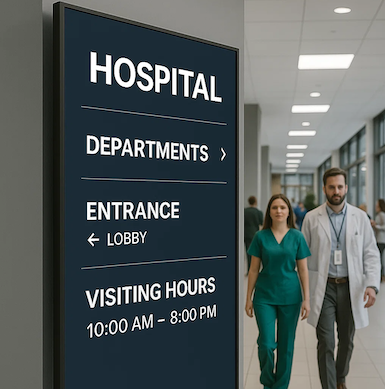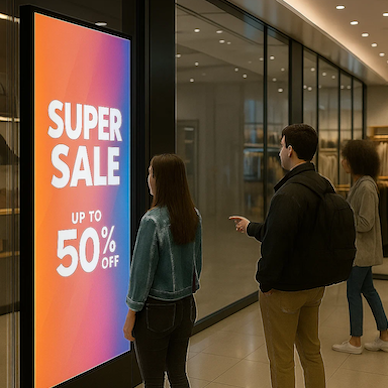Ultimate Digital Signage Hardware Buyers Guide: Selecting the Best
Choosing the right digital signage hardware can feel like navigating a minefield. With the stakes high and the potential for costly mistakes even higher, it's crucial to arm yourself with the right information before making a decision.
We've seen firsthand how the wrong hardware choice can lead to system crashes, display errors, and a slew of other issues that not only frustrate customers but can also tarnish a brand's reputation. Especially for those planning to deploy digital signage across expansive spaces, the importance of getting it right cannot be overstated.
That's why we’re diving deep into the essentials of selecting digital signage hardware. From dissecting the tech stack to pinpointing what makes a vendor stand out, we’ll guide you through the key factors that ensure you find the perfect fit for your needs. Whether you're a seasoned pro or new to the digital signage scene, this buyer's guide is designed to navigate you through the complexities of hardware selection, ensuring your digital signage project is a success from the get-go.
Understanding Digital Signage Hardware Needs
In the realm of digital signage hardware, selecting the right components is pivotal. The aim here is to shed light on how to approach these decisions. Recognizing your specific needs first can make the whole process smoother and more efficient.
Assessing Your Display Objectives
Identifying your display objectives stands as the initial step toward choosing suitable digital signage hardware. It involves determining what you want your digital signage to accomplish. Whether it's for advertising, information dissemination, or enhancing customer experiences, the purpose directly influences the type of hardware you'll need.
For instance, high-traffic areas such as retail stores or busy sidewalks may require digital signs with high brightness levels to remain visible in bright lighting conditions. On the other hand, if the goal is to showcase intricate artwork or detailed information, screens with higher resolution will be paramount. Understanding these objectives early on ensures that the selected hardware aligns perfectly with your signage goals, ultimately contributing to the success of your digital signage deployment.
Importance of Location: Indoor vs Outdoor
The location of your digital signage plays a crucial role in the selection process. Indoor and outdoor environments pose different challenges and requirements for digital signage hardware, from screen brightness to durability against the elements.
Indoor digital signs typically don't need to be as bright as their outdoor counterparts. Lighting conditions can be more controlled, allowing for screens with a brightness level around 150-250 nits. However, in outdoor settings, screens must combat direct sunlight, necessitating brightness levels that can reach upwards of 2000 nits for clear visibility.
Durability is another key factor. Outdoor digital signage requires hardware that can withstand various weather conditions, including rain, snow, and extreme temperatures, without faltering. This means looking for hardware that not only meets the technical specifications for your display objectives but also is robust enough to endure the specific challenges posed by its intended location.
By considering these critical aspects, you can be confident in narrowing down your hardware options to those best suited to your digital signage project. Remember, the right hardware not only enhances the effectiveness of your digital signage but also maximizes your investment in the long run.
Selecting the Right Display
Selecting the appropriate display is a critical step in optimizing digital signage for maximum impact. Given the array of options available, understanding the nuances of display types, size, resolution, and visibility factors enables one to tailor selections to specific project needs. Drawing from experience, we'll guide you through choosing the right display that aligns with your digital signage goals.
Display Types and Technologies
Digital signage displays come in various types and technologies, each offering distinct advantages. LED displays, known for their brightness and efficiency, are suitable for both indoor and outdoor settings. They excel in visibility, even under direct sunlight, making them ideal for high-traffic areas. Projection displays, on the other hand, offer flexibility in size and are excellent for creating immersive experiences in controlled lighting environments. When selecting a display type, consider the environment and how the audience will interact with the content. For areas with high ambient light, LED screens are preferable, whereas projection systems might serve better in dimmer, more controlled spaces where a larger viewing area is needed.
Display Size and Resolution
The size and resolution of a display are closely linked to viewing distance—they determine how clearly content can be seen from various positions within a space. As a rule of thumb, larger spaces require larger displays with higher resolutions to ensure legibility and clarity. For smaller rooms or closer viewing distances, a Full HD (1920x1080 pixels) display might suffice. However, for larger spaces or situations where viewers stand further away from the screen, we recommend opting for 4K UHD (3840x2160 pixels) displays. This ensures that texts and images remain sharp and engaging, even at a distance. Additionally, considering the 468 Rule helps in selecting a display size ideal for educational or professional environments, ensuring everyone in the room has a clear view.
Brightness and Visibility Factors
Brightness, measured in nits (cd/m²), is a crucial factor in ensuring your digital signage is visible in its intended environment. For indoor displays, a brightness level ranging from 300 to 500 nits is often sufficient. However, for outdoor displays or areas subjected to direct sunlight, consider screens with a brightness of 2000 nits or more. This high brightness level prevents the display from appearing washed out, thereby maintaining vibrant colors and clear content visibility. Additionally, it's important to consider the ambient lighting conditions of the signage location. In brightly lit or outdoor settings, higher brightness levels are essential, whereas, in dimmer indoor environments, moderate brightness levels are adequate. Understanding the interaction between display brightness and environmental lighting conditions ensures effective content delivery to your target audience.
By meticulously considering display types and technologies, size and resolution, and brightness and visibility factors, you can select the right digital signage display that meets your specific needs. This attention to detail not only enhances the viewer’s experience but also maximizes the return on your digital signage investment.
Content Players and Media Devices
Choosing the right digital sign player or media device is crucial in the deployment of digital signage. These devices, often overlooked, play a significant role in ensuring your content is displayed seamlessly and effectively. In this section, we'll guide you through understanding their importance, focusing on purpose and performance requirements, and compatibility considerations.
Purpose and Performance Requirements
When selecting media devices for digital signage, it’s essential first to define their purpose. These devices serve as the backbone, transmitting content to your displays. Whether you're displaying high-definition videos, interactive applications, or real-time data feeds, your selected media player must meet the specific demands of your content.
Performance requirements vary significantly depending on the complexity of the content and the number of screens in your network. For high-resolution video walls or interactive displays, look for devices with powerful processors and ample memory to handle the workload without lag or crashes. Devices should have the capacity to run your content smoothly, especially if the signage is intended for customer engagement or critical information display.
Moreover, the performance of your content players directly impacts your digital signage's effectiveness. Fast loading times and high-quality playback are non-negotiable for capturing and retaining audience attention. Assessing the hardware specifications against your content needs ensures your media player supports your digital signage goals, providing a seamless viewing experience.
Compatibility Considerations
Compatibility is another major factor that influences the choice of content players and media devices. These devices must seamlessly integrate with your existing digital signage software and hardware components. Ensuring compatibility with your displays, network infrastructure, and software is paramount.
First, verify the connectivity options of the media player. It should have the necessary ports and internet capabilities to connect with your digital signage displays and network. Whether through HDMI, DisplayPort, or wireless connections, the right media player facilitates a simple setup process.
Second, consider the operating system (OS) or software compatibility. Some digital signage solutions are optimized for specific OS, such as Windows, Android, or Linux, making it important to choose a player that supports your software ecosystem.
Finally, think about future scalability. As your digital signage network grows, so do your compatibility considerations. Opt for media devices that support updates and can adapt to new standards or technologies. This foresight ensures a longer lifespan for your investment and smoother expansions or upgrades.
Careful assessment of content players and media devices according to their purpose, performance requirements, and compatibility considerations is key. By ensuring these elements align with your digital signage strategy, you're set to create a compelling and effective viewer experience. Armed with the right information, you can make the best choices for digital signage deployments, maximizing both impact and return on investment.
Installation Essentials
Jumping into the core of digital signage installation essentials, we’ll guide you through two critical components that ensure your digital signage system not only looks professional but also functions safely and efficiently. Handling these aspects with care elevates the overall experience for both the viewers and the operators.
Mounting Options and Safety
Choosing the right mounting hardware for your digital signage displays is paramount. The size and weight of the display dictate the type of mount you'll need, with options ranging from wall mounts, ceiling mounts, to freestanding enclosures. The top priority here is ensuring the mounts are robust enough to securely hold the display. This prevents any potential accidents or theft, which is crucial in public spaces.
Safety doesn't stop at choosing strong mounts. Ensuring that the display is installed at the optimal height and angle guarantees the best viewing experience. This involves considering the viewing distance, the average height of your audience, and the display's orientation relative to natural light sources to minimize glare. Moreover, ADA compliance for public spaces cannot be overlooked; ensuring the mounted display doesn't protrude into walkways or obstruct emergency exits is a legal necessity.
Power and Connectivity Needs
Equally important to the physical mounting of your digital signage is ensuring it has the necessary power and connectivity to deliver your content seamlessly. A common oversight during installation is underestimating the power needs of the system. Each component, from the display to media players and extenders, requires a reliable power source.
Connectivity is the lifeline of digital signage, linking your content management system to the displays. Wired connections like HDMI or Ethernet offer reliability, but they can be restrictive due to distance limitations. Wireless options provide flexibility and a cleaner setup but keep in mind potential issues with bandwidth and signal interference. The choice between wired and wireless will depend on your specific needs, such as the location of the digital signage and the type of content you plan to showcase.
In sum, addressing mounting options and safety alongside power and connectivity needs lays a solid foundation for a digital signage system that not only complements the aesthetics of its environment but also operates smoothly and efficiently. Ensuring these elements are in check before moving forward can save you a lot of time and hassle in the long run.
Maintenance and Support
Following some details into the essentials of digital signage hardware, we now turn our focus to a crucial facet often overlooked until it's urgently needed: Maintenance and Support. This aspect is fundamental in ensuring the longevity and efficacy of your digital signage hardware.
Warranty and After-Sales Service
Our first piece of advice is to scrutinize the warranty and after-sales service offered by your digital signage hardware vendor. A comprehensive warranty is your first line of defense against unforeseen malfunctions or failures, offering peace of mind in the investment you've committed to. Vendors who stand behind their products typically offer warranties that cover a broad spectrum of potential issues, extending beyond the basic one-year coverage.
Beyond the warranty, after-sales service quality is critical. Opt for vendors who provide substantial technical support, ensuring help is available whenever needed. This support can range from troubleshooting guidance, hardware replacement services, to direct technician assistance for more complex issues. The availability of adequate after-sales service guarantees that any disruptions in your digital signage operations can be swiftly and effectively addressed, minimizing downtime and maintaining continuous engagement with your audience.
Upgrades and Long-term Scalability
Considering the rapid pace of technological evolution, the digital signage hardware you choose today might need an update sooner than you think. It's why I emphasize the importance of selecting hardware with upgrades and long-term scalability in mind. Ensure your vendor offers regular software updates and product enhancements that keep your system on the cutting edge, enhancing performance and unlocking new capabilities over time.
Moreover, scalability should be a cornerstone of your digital signage strategy. Your chosen hardware must be capable of adapting to growing or changing business needs. Whether you're expanding the number of screens across multiple locations or needing to integrate advanced interactive features, ensuring your system is built for easy scalability will safeguard your investment and provide flexibility for future growth.
When exploring digital signage solutions, the focus is not just on the immediate needs but also on the journey ahead. The realm of maintenance and support is a testament to the vendor's commitment to their product and, implicitly, to their customer's success. As you tread through the digital signage hardware landscape, let the pillars of a comprehensive warranty, stellar after-sales service, and provisions for upgrades and scalability guide your path to a fruitful selection.
Budgeting for Digital Signage
When it comes to deploying digital signage, understanding the financials involved is key to making informed decisions that align with both your budget and your communication goals. These next sections will take you through the essential components of budgeting for digital signage, focusing on hardware and software costs, as well as the total cost of ownership and its impact on ROI.
Costs Breakdown: Hardware and Software
Breaking down the costs, we see that hardware and software are the two main investments in a digital signage system. The hardware component typically includes displays, media players, mounts, and any network components necessary for connectivity. For demanding applications, professional-grade digital signage displays are paramount. Prices for these can vary significantly based on size, brightness (measured in nits for visibility under various lighting conditions), resolution, and whether the screen is intended for indoor or outdoor use.
Software, on the other hand, encompasses the digital signage content management system (CMS), which allows for the creation, scheduling, and management of content remotely. Here, choices range from simple platforms suitable for displaying static images and basic animations to more sophisticated systems offering interactive functionalities, integration capabilities, and real-time data manipulation.
An initial investment also goes into installation and setup. This includes not just the physical mounting of the screens, but also the configuration of software and integration into existing IT infrastructures, if necessary. Given the range of hardware specifications and software functionalities, costs can fluctuate widely, making it crucial for businesses to clearly define their requirements and priorities early in the planning process.
Total Cost of Ownership and ROI
Understanding the total cost of ownership (TCO) is critical for a comprehensive view of your digital signage investment. Beyond the initial purchase and installation costs, TCO includes ongoing expenses such as maintenance, content creation, software updates, and electricity consumption. High-quality, commercial-grade screens and professional digital signage software might come with higher upfront costs but tend to offer greater longevity and reliability, often resulting in lower maintenance and replacement costs down the line.
Calculating the return on investment (ROI) involves weighing these costs against the benefits gained from the digital signage solution, such as increased customer engagement, improved communication efficiency, and enhanced sales in retail environments. A well-planned digital signage system, tailored to the specific needs and customer engagement strategies of the business, can offer significant competitive advantages and pay dividends over time.
By focusing on not just the acquisition costs but also the long-term operational and maintenance expenses, businesses can make strategic decisions that optimize both their financial outlay and the effectiveness of their digital signage systems. This strategic approach to budgeting ensures that the selected digital signage hardware not only meets the immediate communication needs but also aligns with long-term business objectives and growth.
truDigital: Digital Signage Experts
At truDigital, we pride ourselves as digital display experts. For nearly 15 years, we’ve guided businesses through the maze of digital signage options, delivering solutions that not only fit their budget, but also amplify their communication objectives.
Mastering the Digital Hardware Experience
Choosing the right digital signage hardware is no trivial task. It demands a nuanced understanding of both content and application needs. At truDigital, we emphasize having a hardware device that is built for digital signage. While other out-of-the-box alternatives such as Google Chromecast or Amazon Firestick are affordable, they often lack the performance, security, reliability, and support that is paramount to creating a smooth experience.
At truDigital, our digital sign player is built to do one thing- support digital signage. Backed by an available 3-year warranty and the industry’s best support team, we ensure your digital signage is always running at peak performance.
Conclusion
Choosing the right digital signage hardware can seem daunting at first. But with the right guidance, like that offered by truDigital, it becomes a strategic decision that can significantly enhance your communication efforts. Remember, it's not just about picking the hardware; it's about understanding the ecosystem— from mounts and cable management to the software that brings it all to life. Partnering with experts ensures not only that you meet your current needs but also that you're prepared for future demands. Let's make your digital signage system more than just a necessity; let's turn it into a strategic asset that drives long-term success.
See it in Action
Get a free, no-pressure demo of our unique platform and find out how it can transform your business.









